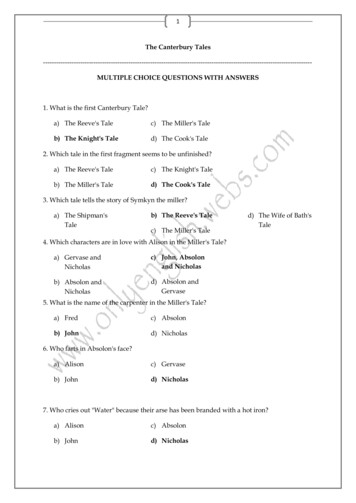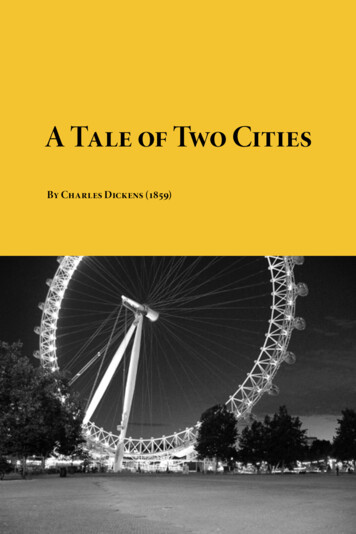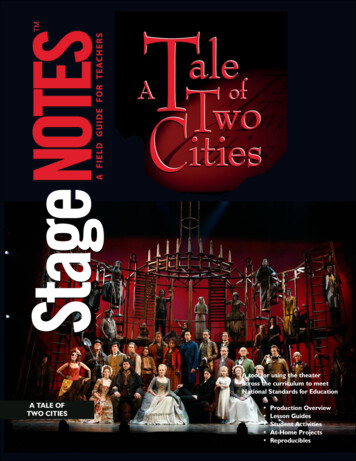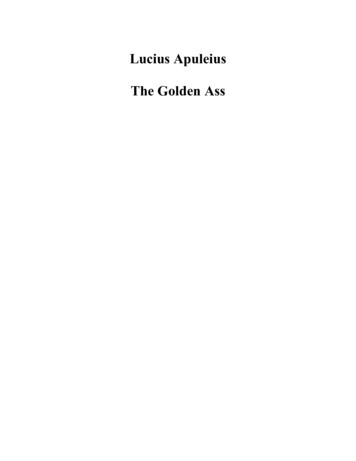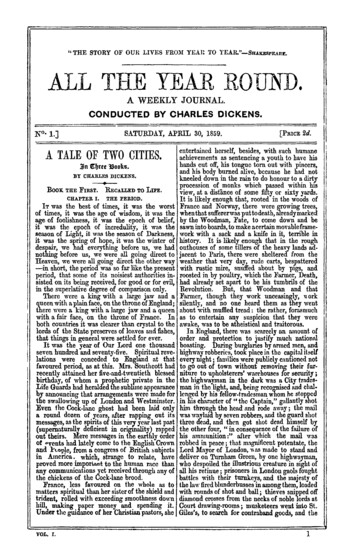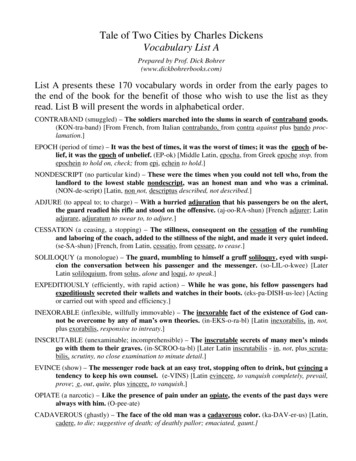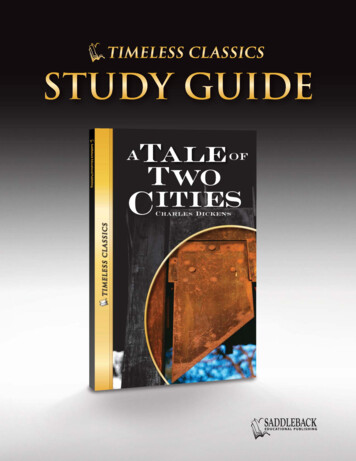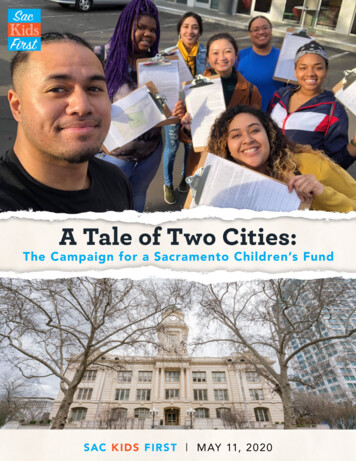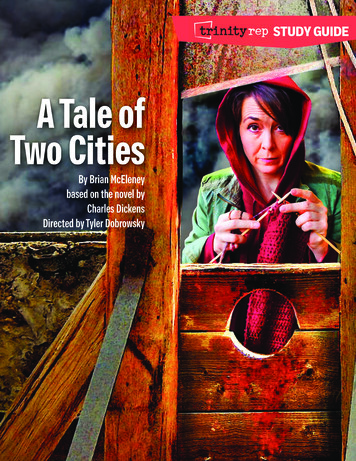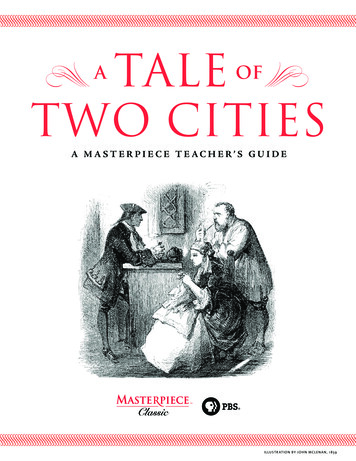
Transcription
TaleTwo CitiesAofA M A S T E R PI E C E T E AC H E R ’ S GU I DEI L L U S T R AT I O N B Y J O H N M C L E N A N , 1 8 59
INTRODUCTIONThis Teacher’s Guide is a resource for educators to be used with the Masterpiecefilm, A Tale of Two Cities. The film, which Masterpiece originally aired in 1989 onPBS, is available for purchase from shopPBS.org.Starring James Wilby, Xavier Deluc, and Serena Gordon, and directed by PhilippeMonnier, the film is a detailed adaptation of Dickens’s complex story of the lives ofEnglish and French characters caught up in the turmoil preceding and during the FrenchRevolution. Written in 1859, A Tale of Two Cities explores issues also associated with otherworks of Charles Dickens: poverty, oppression, cruelty, social disruption, justice, personalredemption, and class struggle. As scenes in the story shift between the cities of Paris andLondon, Dickens explores these themes in both locations. The circumstances that provokedthe revolution, as well as the chaotic consequences of the revolutionaries’ victory, serve as awarning directed at unaddressed and unresolved social concerns in England. Everywhere,poverty and oppression stand in sharp contrast to justice and love. Through the lives ofcharacters drawn from many class levels in both England and France, Dickens weaves hisintricate plot.A master of dramatic narrative full of vivid scenes and coincidences, Dickens is able to linkthe lives of diverse characters who represent the competing forces of that memorable era.To this day, Madame Defarge personifies revenge, just as the Marquis St. Evrémondestands for corruption and cruelty. Sydney Carton represents the extremes to which onemight go to salvage a wasted life. Finally, the lives of these characters offer proof that,indeed, “it was the best of times, it was the worst of times.”Using the FilmThe film is as dramatically entertaining as it is instructive. You may choose to teach thefilm A Tale of Two Cities on its own, in conjunction with or as a preview to readingthe novel, or as part of a larger unit on Dickens or any of its themes. The film, which can beparticularly useful in helping to bring to life specific features or scenes from the text, clearlyconveys the essence of Dickens’s thematic concerns. Characters and settings are portrayedin a manner which respects the integrity of the novel, and for students who have difficultymastering Dickensian prose, the film can serve as an invaluable instructional aid.Note: The film containsseveral scenes of violence.Be sure to preview the entirefilm before using it in class.Disc One of the 2-set DVD is approximately 104 minutes and Disc Two is about 93minutes. You may want to divide up classroom viewing to coincide with your students’reading of the text; to prepare students before they read the book or a particular section;to continue classroom discussion after students have read the book; or simply accordingto the time you have per classroom session. You may also use the scene selection option tofocus on a specific character or part of the plot.Page 2
Using the Teacher’s GuideAImage scan and text by Philip V. Allingham 8.htmlTale of Two Cities not only explores the conditions in France and England in the late18th century, but also encompasses the perspective of Dickens, living in 19th-centuryEngland. To fully understand the book and the film, you will probably want students toresearch the causes and effects of the French Revolution, as well as similar issues in Englandduring the same time. You may want to divide the class into teams and assign them differenttopics to explore and/or create a class wiki with the information that students discover.You may also want to consider an interdisciplinary approach to teaching the book, teamingup with a history teacher to help explore in depth the social, economic, and politicalimplications of the story. Providing biographical details about Dickens and his time willalso help students understand the lens through which Dickens wrote about events thatoccurred 100 years earlier.CO V E R O F T H E O R I G I N A L E D I T I O NB Y P H I Z , 1 8 59This guide presents an integrated approach to teaching A Tale of Two Cities. The lessons drawparallels between social conditions of the past and present and compare the developmentof democracy in England, France, and the United States. The activities in the guide help todevelop research, speaking, and debating skills, and promote cooperative learning.Although you may choose to show the film in a variety of ways, the Teacher’s Guide dividesthe viewing into four “episodes.” Each episode provides a plot summary, discussion questions,and activities that address a range of student capabilities and learning styles. You maywish to modify or customize the activities according to the neeeds and capabilities of yourstudents. Background information on Charles Dickens, the French Revolution, and selectedtopics are also included.In addition to this Teacher’s Guide, there are many rich resources found on theMasterpiece Web site at pbs.org/masterpiece. Here are just some of the links youcan check out:Teaching Dickens: A Masterpiece ickensteachersguide.pdfThis online guide offers general lesson plans about Dickensand specific discussion questions and activities for OliverTwist, David Copperfield, Little Dorrit, and The Old CuriosityShop. “Stay Tuned: The Rise of the Killer Sequel,” an essay onhow Dickens transformed “serial suspense into a large-scalesocial event,” is also included, as are recommended websitesand books.Teaching DickensA Masterpiece GuidePage 3
Dickens Book & Film uides.htmlAimed primarily at book and film clubs, this guide contains lively discussion questions,activities, and period recipes for the same four Dickens titles as Teaching Dickens:A Masterpiece Guide.Charles Dickens y prepared for the 2000 Masterpiece film David Copperfield (starring a veryyoung Daniel Radcliffe), this is a useful set of dates related to Dickens’s life.Down and Out in Victorian ist/ei downandout.htmlThis essay, created for the 2000 Masterpiece film Oliver Twist, offers a look at theconditions endured by the poor in 19th-century England, as well as institutions such aschild labor and workhouses.Dickens and His TimeCharles Dickens was born on February 7, 1812, the second of eight children.Throughout most of his childhood, the family was burdened with debt. In 1823,his father, John Dickens, was arrested and sent to the Marshalsea Debtor’s Prison,where he was soon to be joined by the rest of his family. At the age of 11, Dickens wasforced to begin work in a blacking factory. The misery of those early years haunted himfor the rest of his life.It was because of these unfortunatecircumstances that Dickens developed alifelong concern regarding abuse of the poor,particularly children. Human suffering,inequality, and injustice are pervasive themesin Dickens’s work. It was through personalexperience that he was able to write soconvincingly about the various social evilsthat prevailed in 19th-century England.D I C K E N S ATH I S D E S K , 18 5 8An unexpected inheritance eventually relievedsome of the family’s burdens, and Dickenswas able to continue his education. At the ageof 15, he began to work for a firm of attorneys in London. Soon afterward, he became afreelance reporter in the law courts and in Parliament. By the time Dickens had turned 25,the serialization of The Posthumous Papers of the Pickwick Club had made him one ofEngland’s most widely-read authors, a popularity he would enjoy for the rest of his life.Page 4
More than any of his other novels, A Tale of Two Cities reveals the complexity of Dickens’ssocial ideas. By the standards of his day, he was a political radical, and many of his novelsexplore specific social problems in great detail. Oliver Twist, for instance, portrays thesuffering and mistreatment of children; Little Dorrit describes the debtor’s prison whereDickens’s family had suffered; and Hard Times is a powerful account of the exploitation ofindustrial workers laboring under devastating conditions. Through his many novels,Dickens created an unforgettable cast of characters, each representing some aspect of theworld in which he lived.Dickens’s work brought issues of mistreatment and hypocrisy into sharp focus. He exposedand satirized corruption, greed, and injustice, while forcefully advocating the interests ofthe poor and downtrodden, especially children. Though Dickens consistently combatedpolitical and social oppression, he feared the violence and upheaval inherent in revolution,as can be seen in his interpretation of the French Revolution in A Tale of Two Cities.Although he was born long after the French Revolution, Dickens himself lived in politicallytumultuous times. In 1830, another revolution had again overthrown the French monarchy.Similar uprisings occurred in other European countries. Although England itself avoidedrevolution, many people feared that if England had not passed the Parliamentary ReformAct of 1832, it too might have suffered from revolutionary violence.In 1848, a revolt once again toppled the French monarchy and inspired another series ofpolitical upheavals throughout the continent. Once more, England was spared a revolution,but the Chartist movement, which had gained strength among the working classes duringthe first half of the century, had led many to fear that violence would break out there aswell. In 1859, as Dickens was publishing A Tale of Two Cities, a series of revolutionsswept through the various states of Italy. In fact, Dickens is said to have begunwork on the book shortly after a bomb killed or injured 100 people in anassassination attempt against the French Emperor Napoleon III. A Tale ofTwo Cities offered a warning to the English that reform would be preferableto revolution.Background to the French RevolutionATale of Two Cities creates the impression that before the revolutionthe French common people suffered from such savage oppression thateventually they rose against their masters in a frenzy of bloodlust and revenge.Other writers, however, have concluded that throughout the 18th century,France was gradually becoming more and more prosperous, and that therevolution came about when the middle classes began to claim an increased shareof political power to reflect their economic importance.EMPEROR NAPOLEON IIIPage 5
P R I SE D E L A B A S T I L L EBY JEAN-PIERRE LOUISL AU R E N T H O U Ë LThe origins of the revolution go back to the 1770s, when the French government took theside of the rebels in the American War of Independence. Although the French governmentwas more interested in weakening English military power than in promoting liberty, thecause of the American Revolution was very popular in France, and many French reformerswere inspired to attempt reform in their own country. The French government, however,had also incurred enormous debts as a result of aiding the colonists, and these debts onlyadded to the burdens of a government that was becoming increasingly unable to meet itsfinancial obligations.The immediate cause of the French Revolution was a fiscal crisis. Unable to pay its debts,the government called for a meeting of the States-General to vote for new taxes. However,this parliamentary body soon demonstrated that it would not be content with simply votingfor new taxes, and thus it called for an extensive series of reforms.The rioting that led to the fall of the Bastille (a notorious fortress and prison) was set offin part by fears that the king planned to use the army to dismiss the States-General byforce. Although the rioters liberated only a handful of prisoners, the capture of the Bastilledemonstrated that the people of Paris were ready to take matters into their own hands ifthe royal government tried to move against the reformers.Page 6
EPISODE ONEBOOK : From the beginning of the novel to the end of Book the Second, Chapter 9(“The Gorgon’s Head”)DVD : From the beginning of Disc One to the end of Chapter 6 (about 54 minutes)Plot SummaryDickens begins the novel with the words, “It was the best of times, it was the worstof times.” This now-famous opening underscores the fact that in any period,good and evil coexist; wondrous events are contrasted with horrible and unacceptableoccurrences. The lives of the characters in the novel and the film reflect this contradictionin the range of human experiences throughout the best and worst of times.In 1775, Doctor Manette, having lost his memory and sanity, is released after 18 years ofimprisonment in the Bastille prison. Manette’s daughter, Lucie, has grown up believing herfather was dead. Mr. Jarvis Lorry of Tellson’s Bank and Lucie are reunited with Manette inParis at the wine shop of Monsieur and Madame Defarge. Lorry and Lucie take him backto England.Five years later, in 1780, Lucie testifies at the London treason trial of Charles Darnay,a young Frenchman she had met on the boat from France to England. In Paris, thearistocratic Marquis St. Evrémonde receives a letter that outlines the evidence that will bebrought against his nephew, this same Darnay, who had moved to London and renouncedhis French lands and title. Darnay has been falsely accused by two notorious police spies,Roger Cly and John Barsad. He is acquitted only after Sydney Carton, a dissolute younglawyer, points out the remarkable resemblance between himself and Darnay, thereforecasting doubt on Barsad’s testimony.T H E W I N E -SH O P B Y P H I Z , 1 8 59Page 7
With his daughter Lucie’s love and total devotion, Manette has now regained his sanity andreturned to practicing medicine. He remembers very little about his imprisonment or theevents leading up to it. However, when Manette is faced with a stressful situation, heobsessively reverts to his prison occupation as a shoemaker.One of the most striking images, in both the film and the novel, occurs when a great caskof wine bursts in the street outside the Defarges’s wine shop. Dozens of people rush to thescene and scoop up the wine as it rushes down the gutter. Some of these people are sodesperate that they get down on their hands and knees and lap up the wine like animals.One man, Gaspard, uses the spilled wine to write the word “blood” on a wall. This actclearly foreshadows the French Revolution.The carriage of the Marquis St. Evrémonde, rushing through the streets of Paris, crushesGaspard’s little boy. The Marquis callously tosses a coin at Gaspard’s feet and continues onhis way. That same night, the Marquis is visited by his nephew. Darnay is disgusted withthe way his family has oppressed the poor. The young man has a plan to undo some of thewrong his family has done, a plan his uncle bitterly opposes. Darnay even suspects that hisuncle played a role in fabricating evidence against him at the trial in England. Darnay andhis uncle quarrel. That night, the uncle is murdered by Gaspard. As he stabs the Marquis,Gaspard whispers the name “Jacques,” revealing his role as a member of the “Jacquerie,” asecret revolutionary society.Discussion Questions1.The opening lines of A Tale of Two Cities are some of the most famous in literature:“It was the best of times, it was the worst of times ” Yet these lines are not spoken atthe beginning of the film. Instead, the film begins with Doctor Mannet in the Bastilleprison. After several moments, the film’s titles are shown. Ask students to commenton the film’s opening scenes. What does it convey about the story? How does theappearance and behavior of Manette set the scene? What draws them into the film?Why do they think the filmmakers chose to not use the famous opening lines at thispoint in the story?2.As they watch the film, have students note where and how starvation, oppression, andcruelty are portrayed in the film. Students may want to keep a written or online journalas they watch the film and read the book. What techniques do Dickens and thefilmmakers use in terms of imagery, descriptive language, costumes, camera angles, andso on? Have students cite specific passages from the book or scenes from the film.3.Ask students to observe the differences in the film between how the poor in France andEngland are portrayed—for instance, the poor people outside the courthouse in Englandand the scene in Paris when the wine cask is broken. What do you think Dickens istrying to express by showing these differences?Page 8
4.What purpose does the scene of the overturned wine cask serve? How does it foreshadowthe French Revolution? How does the scene with the carriage accident build upon thewine scene? Ask students to comment on how these two pivotal scenes made them feel.5.Have a student volunteer to read aloud the first two paragraphs of Book the First,Chapter 5, which describe the breaking of the wine cask. (Begin with the sentence “Alarge cask of wine had been droppd and broken, in the street.” End with the sentence, “ if anyone acquainted with it could have believed in such a miraculous presence.”Have students jot down key words that Dickens uses to convey images of poverty anddesperation. Could that scene occur today in this country or around the world? If so,under what circumstances?6.Music plays a very important part in filmmaking. Have students critique the use ofmusic in the opening scene and in the scene where the Marquis St. Evrémonde is servedcoffee by a long line of servants. How does the music enhance the scene? Have studentslisten and note other uses of music as they watch the film.Activities1.Distribute the Character Chart on page 24. Ask students to identify and describe eachcharacter they have met so far and their relationship with others on the list. As they viewthe film, have students add their observations to the chart.2.Poverty is an issue that Dickens explores in many of his works. Have students findtwo articles online or in the newspaper about poverty in their neighborhood, region,or around the world. How do the issues of poverty that people struggle with todaycompare to what the French and English experienced in the 18th century? How hasour attitude towards poverty changed or remained the same since then? What remedies,if any, are offered today?3.Dickens is known for his keen and evocative descriptions. Have students take turnsreading aloud the passage in Chapter 5 (“The Wine-Shop”) that describes the DeFarge’sneighborhood. (Begin with the line “And now that the cloud settled on Saint Antoine ”and end with “Indeed they were at sea, and the ship and crew were in peril of tempest.”)Working individually or in pairs, ask students to think about a neighborhood or areathey know well and write a one-page description of it as Dickens might have described it.4.Have students cover the scene in which Gaspard’s son is killed as a news story.Brainstorm and explore the differences among the various kinds of news stories today:a who-what-where-when-why newspaper story, an investigative report, a TV nightlynews story, a blog, a 24-hour cable news network story, a radio story, and so on.Choosing one of the news styles, and working in teams, pairs, or individually, havestudents cover the scene in which Gaspard’s son is killed. After students deliver theirreports, reflect on how various media outlets affect our perception of events.Page 9
6.Dickens’s novels often include one or more courtroom scenes. In the film, the courtroomscene is crucial. It not only introduces us to Darnay and other important characters, itcontains many of the issues the story explores. Why did Dickens write so much aboutthe law? Why are legal matters often so deemed to be dramatic? Have students make alist of current films and television shows that use courtroom scenes for their dramaticcore. What are some of the similarities and differences between Dickens’s use of thissetting and more contemporary uses?T H E L I K E N ESS B Y P H I Z , 1 8 59J AC Q U E R I EThe Defarges have a large circle of friends, most of whom are called “Jacques,” acommon French first name. “Jacques” is simply a code name used to concealtheir true identity from strangers and perhaps from each other. They form a secretsociety, at first keeping track of aristocratic crimes, and later bringing their enemiesto trial and execution once the revolution has begun. In fact, it is unlikely that secretsocieties played an important role in the French Revolution. Most of the majorrevolutionary groups, such as the Jacobins and Girondins, operated quite openly.Secret revolutionary societies were actually more important in Dickens’s own time.He may have drawn inspiration from such secret groups as the Carbonari, whichoperated in Italy.Page 10
EPISODE TWOBOOK : From Book the Second, Chapter 10 (“Two Promises”) through Book the Second,Chapter 21 (“Echoing Footsteps”)DVD : From the beginning of Chapter 7 to the end of Disc One (about 46 minutes)Plot SummaryAfter the Marquis’s death, Darnay returnes to London where he is now working as ateacher. In the summer of 1781, on a visit to Doctor Manette, Darnay announcesthat he wishes to marry Lucie. When Manette gives his blessing, Darnay wants to reveal histrue identity. Manette stops him, saying that if Lucie accepts the proposal, Darnay canreveal his identity on the day of the wedding.In addition to working officially as a messenger for Tellson’s Bank and as Lorry’s assistant,Jerry Cruncher robs graves to supplement his income by selling cadavers for medicalresearch. That same summer, there is a funeral for the police spy Barsad. When Cruncherand his accomplices open the grave to steal the body, they find that the coffin is full of dirtand rocks.In France, Gaspard, the murderer of the Marquis St. Evrémonde, is executed. Therevolutionaries have sworn vengeance against all members of the St. Evrérmonde family.Meanwhile, Barsad has begun working in Paris for the French government. The Defargesand their friends, however, quickly realize that he is a spy when he begins asking suspiciousquestions. Knowing that the Defarges had sheltered Manette after his release from prison,Barsad tells them that Lucie Manette is about to marry Charles Darnay, the nephew of theMarquis St. Evrémonde.Shortly before the wedding of the two lovers in England,Sydney visits Lucie, asking her to remember that hewill always be ready to give his life for her or foranyone she loves. On the day of the wedding,Darnay reveals his true name to Manette.Although he seems at first to take the news well,Manette falls into a fit of madness while Darnayand Lucie are away on their wedding journey.He soon recovers, however, and begs Lorry not totell Lucie what has happened. At the very end ofDisc One, the action skips forward eight years toshow the fall of the Bastille in 1789.I L L U S T R AT I O N B Y J O H N M C L E N A N , 1 8 59Page 11
T H E SE A R I SES B Y P H I Z , 1 8 59Discussion Questions1.Discuss what triggers Manette’s relapses. What clues from the film hint at the reasons?Have students research the condition now known as post-traumatic stress disorder.How might Manette’s flashbacks and psychological setbacks be diagnosed today?Mr. Lorry suggests that burying his shoemaking tools might help Manette put hisimprisonment behind him. What might the treatment be today?2.Although many of the French characters are working-class people, Cruncher is the onlyprominent English character from the working classes. Ask students to compare andcontrast Cruncher to the French characters, such as the Defarges and their friends.3.Although A Tale of Two Cities concentrates on the French Revolution, the treason trialof Darnay and the mob scene at Barsad’s funeral take place in England. Does Englandappear to be almost as dangerous a place as France? Why or why not? Is England nearlyas ripe for revolution as France? How do these early scenes of violence and injustice inEngland prepare the reader or viewer for the coming scenes of the French Revolution?What message or warning is Dickens expressing?4.Dickens often uses the names of his characters to reveal something about thoseindividuals. Have students refer to the list of characters they created at the beginningof the film. How do the names Jarvis Lorry, Jeremiah Cruncher, Mr. Stryver, SydneyCarton, Ernest Defarge, and Alexandre Manette reveal their character’s traits?5.Consider the very last scene of Episode Two: a young girl stares at the buckled shoesof a hanged man. What does this scene evoke? Why do you think the filmmakers chosethis image?Page 12
Activities1.The two main women characters in A Tale of Two Cities are Madame Defarge andLucie Manette. What do each of them symbolize for Dickens? Consider how eachwoman is portrayed in the film. How do the filmmakers convey the women’spersonalities? Ask students to re-cast the film using today’s actors. Working in pairs,have one student pretend to be an agent and another to be a studio executive. Have theagent present his or her “pitch” as to why his or her client would be perfect for the role.Have the studio executive respond, explaining whether or not the actor would be ableto embody the character.2.When Darnay wants to reveal his true identity to Doctor Manette, the doctor stopshim. He tells Darnay, “Tell me when I ask you, not now. If your suit should prosper, ifLucie should love you, you shall tell me on your marriage morning.” Working in smallgroups, have students develop three possible reasons to explain Doctor Manette’sresponse to Darnay. Have each group present their explanations to the class, and thentake a class vote to see which reason the class finds most plausible.3.Give students the following assignment: Imagine that you are an American visitor toParis during the storming of the Bastille. Write to a friend in the United States anddescribe what you observed during the course of that fateful night, either according tothe film or based on your own research of historical accounts.R ESUR R ECTION MENIn the 18th and early 19th centuries, there was a severe shortage of cadavers forthe training of students in medical schools and hospitals. “Resurrection men” likeCruncher carried on an illicit trade in corpses, which they often obtained by robbingnew graves.In real life, the two most notorious resurrection men were two Scotsmen namedBurke and Hare, who began, like Cruncher, by robbing graves. Burke and Hare,however, couldn’t dig up corpses as fast as they could sell them. They decidedto speed up the process by murdering people and selling bodies to doctors inEdinburgh. It is not known how many people they may have murdered before theywere caught. Their scheme finally came apart when a medical student recognizedthe body of a murdered prostitute he had known. These crimes took placewhen Dickens was young. People who read Dickens’s books when they were firstpublished would have remembered the real-life resurrection men.Page 13
EPISODE THREEBOOK: From Book the Second, Chapter 22 (“The Sea Still Rises”) to Book the Third,Chapter 10 (“The Substance of the Shadow”)DVD: From the beginning of Disc Two to the end of Chapter Seven (about 54 minutes)Plot SummaryOn July 14, 1789, rioters seize the Bastille prison in Paris. Defarge forces one of thejailers to take him to Manette’s old cell, 105 North Tower. Defarge completes athorough search of the cell.Three years later, in the autumn of 1792, the crowd at Tellson’s Bank in London is talkingabout the events of the Revolution. Many French aristocrats have taken shelter in England.Some English firms, such as Tellson’s Bank, still do business in France. Lorry is sent to Paristo look after the interests of the bank.Back in England, Darnay learns that Gabelle, an old family servant, has been chargedwith treason. Telling only Manette, Darnay leaves for France to help Gabelle. Unknownto Darnay, Gabelle’s letter was sent in order to lure him back to France to face trial as amember of the French aristocracy. After being recognized as a former aristocrat, Darnay isarrested almost immediately in Paris and sent to La Force prison, where he is held in secret.Lucie and her father follow Darnay to Paris. Since Manette was a prisoner in the Bastille,he has become a hero to the Paris mob and is able to use his prestige to protect Darnay.Madame Defarge visits Lucie and her child. When Lucie asks for help in obtainingpermission to visit Darnay, Madame Defarge replies, “Your husband is not my businesshere. You are my business here.”T H E K N O CK AT T H ED O O R B Y P H I Z , 1 8 59Page 14
Carton also comes to Paris and soon recognizes Barsad, the police spy. Carton confrontsBarsad, who is now working for the French revolutionary government, and tells him that hewill soon demand a favor. Barsad is vulnerable to blackmail because of his former work as aspy for both the French aristocracy and the British government.Finally, Darnay comes to trial and is acquitted, largely because Manette speaks in hisdefense. That evening, Darnay is arrested again. He is told that he has been denouncedby the Defarges and by a third person, whose name he will learn at the trial. At Darnay’ssecond trial, it turns out that his third accuser is Manette himself.During the storming of the Bastille, Monsieur Defarge had found a document that Manettehad written while in prison. The document reveals that in 1757 two French aristocrats, thefather and uncle (the Marquis St. Evrémonde) of Darnay, had taken Manette to the bedsideof a young woman who was driven insane and was now dying in agony. In an adjoiningroom lay the young woman’s brother, dying of a sword wound. The brother died that night,while his sister lingered for a few more days before her death. Manette learn
Revolution. Written in 1859, A Tale of Two Cities explores issues also associated with other works of Charles Dickens: poverty, oppression, cruelty, social disruption, justice, personal redemption, and class struggle. As scenes in the story shift between the cities of Paris and London, Dickens explores these themes in both locations.

